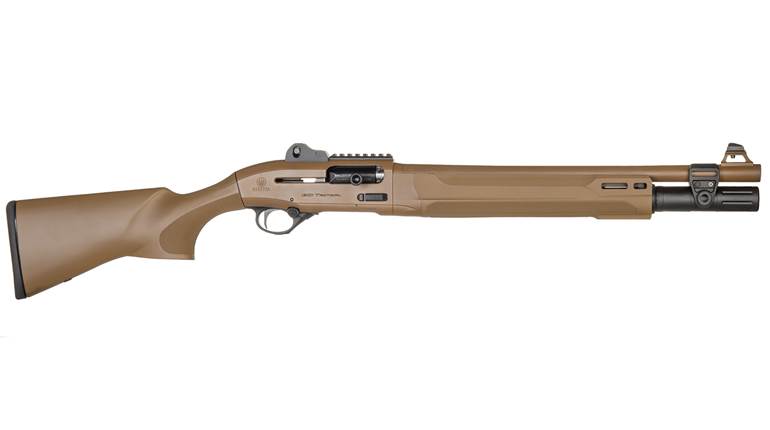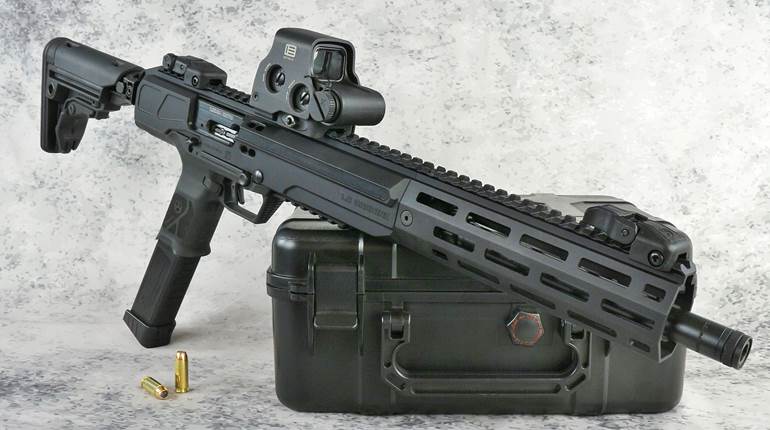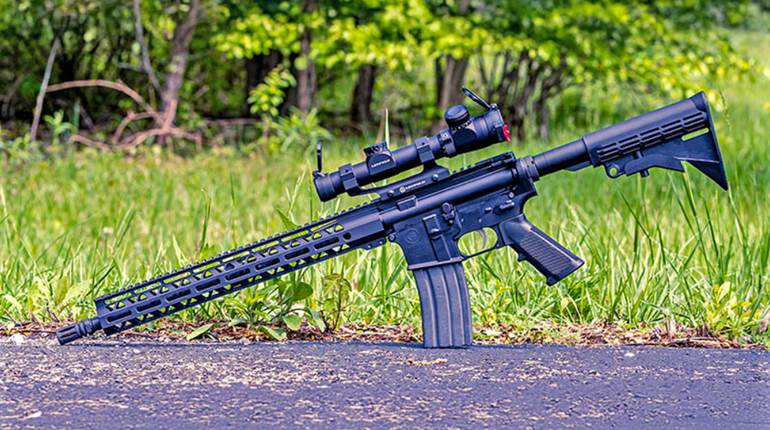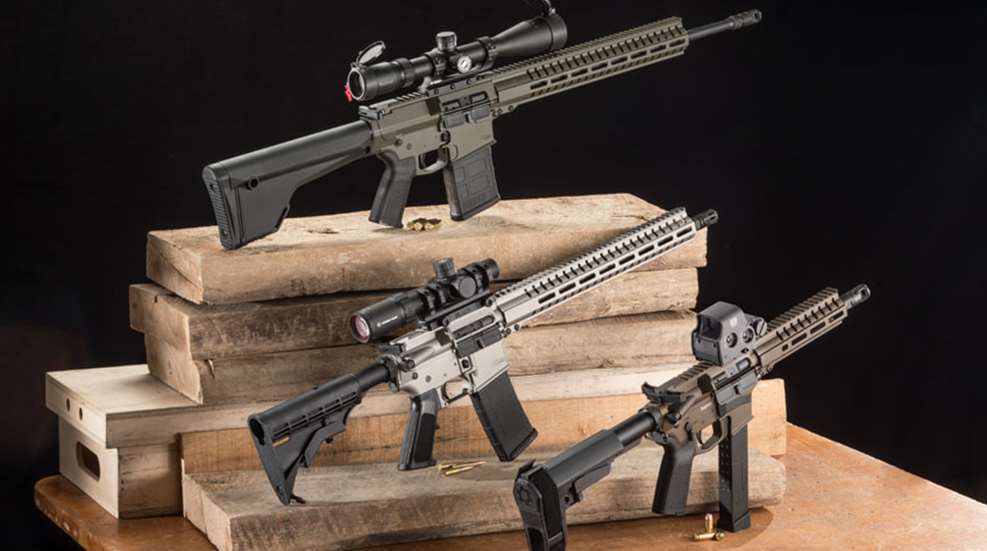
Simultaneously an embarrassment of riches and predictable in its homogeneity, the AR market provides potential buyers with more options than you can shake a stick at—as long as what you want is a 16"-barreled carbine chambered in .223 Remington. But if you’re interested in pretty much anything else, your options are far more limited. Which is borderline tragic, since Eugene Stoner’s modular design gives it the versatility to excel in an array of specialized shooting pursuits, using a slew of disparate cartridges.
Most AR manufacturers have shied away from what I call non-NATO ARs (those AR-15s chambered in anything but .223 Rem./5.56x45 mm NATO and those AR-10s that don’t fire .308 Win./7.62x51 mm NATO), dismissing them as fringe, esoteric offerings that aren’t worth the trouble to design and produce in quantity. Yet the success of a relative newcomer to the scene has put the lie to the industry’s assertion that these various niches aren’t popular enough to be profitable. Thriving in the margins where others fear to tread, CMMG has made a good name for itself by specializing in high-quality ARs chambered for all those other worthy cartridges that just weren’t blessed with military adoption and the civilian market ubiquity that accompanies it.
A Little History Behind CMMG
The tale of CMMG is a good-old-fashioned, all-American success story—a small-town operation that, through gumption, innovation and the willingness to take chances, has pulled itself up from the humblest of beginnings to a place of standing within the industry. That it has done so by producing AR-15s, today nearly as much of an indelible national icon as baseball or apple pie, is all the more fitting. Founded by brothers Jeff and John Overstreet, CMMG began life in 1999 as a website that sold AR-platform parts and accessories that were compliant with the then-still-extant so-called “Assault Weapons” Ban of 1994. But after only a few years, the decision was made to start making rifles for themselves, and in February 2002, CMMG, Inc., was formed for just that purpose.
Initially, the entire workforce consisted of only four people—the brothers, Jeff’s wife Stephanie and John’s wife Gretchen—assembling guns from the privacy of an outbuilding on the family farm outside of Fayette, Mo. By 2006, however, steady growth had forced the hiring of a fulltime staff, and the building was enlarged multiple times in order to accommodate both the burgeoning workforce and the acquisition of manufacturing equipment that allowed CMMG to begin fabricating its own parts.
So modest was the Fayette facility that power outages were common (the employees then using the downtime to either clear brush from the property or to play volleyball on a net hung just outside the door) and delivery trucks couldn’t even navigate the gravel driveway. Each morning, workers would have to cart the previous day’s wares to the end of the road to be loaded onto the trucks. Remarkably, CMMG operated from that location until 2016, when the need for further expansion (and consistent electricity) prompted a move 25 miles down the road to a much more suitable—yet still unpretentious—factory in nearby Boonville.
Yes, first came 5.56x45 mm NATO AR-15s just like everyone else, but throughout its first decade CMMG slowly expanded the breadth of its offerings to include direct-impingement center-fires in a wealth of cartridges, not to mention blowback-operated models chambered in 9 mm Luger and .22 Long Rifle. But it’s within the past five years that things really started getting interesting over at CMMG. In 2015 came the release of the Mutant (one of the first reliable chamberings of the Russian 7.62x39 mm cartridge in the AR platform), followed by the 2017 invention of a proprietary method of autoloading operation (Radial Delayed Blowback) during development of the .45 ACP-firing Guard rifle.
Getting the AR platform to function properly with a new chambering is a little more complicated than just slapping a new barrel on there, and, as a result, CMMG puts as much emphasis on an active R&D department as any company I’ve encountered. So it should come as no surprise that, while there hasn’t been a ton of innovation within the AR realm during the past decade, CMMG has been responsible for much of it.
Today, the company’s portfolio encompasses 16 cartridges thanks to a busy 2019 that saw the addition of models chambered in 350 Legend, .40 S&W and 10 mm Auto to the catalog—with NATO-cartridge ARs composing just a small sliver of total sales. Also last year, as part of a rebranding effort that included a new logo, CMMG simplified its product lineup by bringing all AR pistols and short-barreled rifles under the Banshee name, all 16.1" carbines under the Resolute designation and all rifles with barrels 18" or longer under the Endeavor line.
The company also further splits each of these families into the 100, 200 and 300 series, which are all functionally identical, but vary in terms of the components that the guns use and the features that they include. The 100s are entry-level, more spartan models, the 300s are the most enhanced and tricked-out options, and the 200s split the difference in terms of both refinement and price.
In an effort to evaluate a little bit of everything that the company makes, I procured from CMMG a new Banshee 300 chambered in 10 mm Auto, a Resolute 100 chambered in .300 Blackout and an Endeavor 200 chambered in 6.5 mm Creedmoor. This allowed me to test three guns—one an AR pistol compatible with Glock-pattern magazines, one an AR-15 and one an AR-10—each occupying a different level of the maker’s three refinement tiers, while also having the opportunity to evaluate both its direct-impingement (DI) and Radial Delayed Blowback (RDB) designs. First let’s discuss the three guns’ common features, then I’ll delve into what sets each apart.
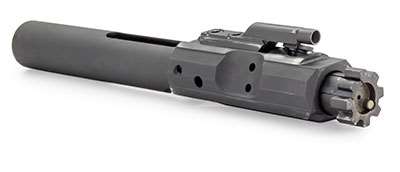
Shared Features
Despite major differences in size and chambering, all three of my test CMMGs follow the standard AR pattern of being detachable-box-fed semi-automatics with an upper receiver and barrel assembly mated to the lower receiver and fire controls via two captive takedown pins. The receivers of all three are hard-coat-anodized 7075-T6 aluminum, however, those of the Banshee and Resolute began life as forgings, while the AR-10’s billet receivers were CNC-machined from bar stock.
Handling the process in house, CMMG also offers an upgraded Cerakote finish on its firearms (standard on 300-series guns, an upcharge on 100s and 200s), and all three of the test samples bore this treatment on their receivers and handguard. There are 10 Cerakote options in total—the Banshee was finished in Midnight Bronze, the Resolute in Titanium and the Endeavor in OD Green.
In each, the cartridge is pulled from the chamber via a sliding-plate extractor on the right side of the bolt, and is expelled through a right-side port by way of a plunger-style ejector opposite it on the left side of the bolt face. Regardless of the action that initiates the cycle, whether DI or RDB, a buffer assembly within the receiver extension slows the rearward travel of the reciprocating bolt carrier group (BCG) and returns it forward again to strip a fresh cartridge from the magazine and load it into the chamber.
Although the company has offered guns with front sight posts in the past, all current models employ M-Lok-compatible free-floating handguards with full-length Picatinny rails along the 12-o’clock positions to match that atop the upper receivers. More refined triggers are available on select CMMG models, but my three samples shared identical single-stage, mil-spec triggers. A bit creepy but predictable, all three broke at pull weights around 5 lbs., 8 ozs., of pressure after about 1/8" of take-up.
While the specifics of the components used vary by gun, the controls of all are situated in their traditional locations. A 90-degree safety selector is just above the pistol grip, a magazine release button is above the magazine well on the right side of the lower, a bolt release lever mirrors its location on the left side of the gun and a handle atop the upper receiver is pulled to the rear in order to charge the firearm. Lastly, a brass deflector and a dustcover are also present on all three test samples.

Banshee 300 (10 mm Auto)
At the time of writing, the Banshee 300 chambered in 10 mm Auto is the manufacturer’s most recent release and the latest application of its RDB system. Conceived of by Product Design Manager Jordan Wilson to provide more reliable functioning of the .45 ACP than either traditional blowback or DI actions could provide, RDB has since been fine-tuned for compatibility with numerous handgun cartridges. The company’s patent for the system was approved on Oct. 8, 2019.
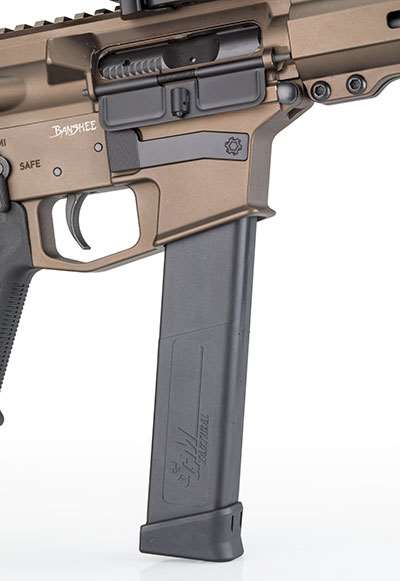
In a standard blowback action, the only things slowing the bolt as it accelerates rearward are its own mass and the resistance provided by the action spring. With RDB, a mechanism has been added to temporarily delay this rearward motion, a rotating bolt that engages the barrel extension, and ignition gases acting on the cartridge case must first rotate the bolt out of alignment before the gun will cycle. This slight delay allows for the use of a significantly lighter BCG and buffer, while likewise slowing bolt velocity, resulting in less felt recoil and a lightened firearm. It’s a simple enough concept, but it makes a big difference.
Customers have been clamoring for a 10 mm Auto CMMG for many years, but adapting the system to the cartridge presented a particular challenge for company engineers, as the energy levels of factory-loaded 10 mm ammunition vary greatly. Understanding that the gun would need to function with everything from full-bore hunting ammunition to “FBI Lite” loads, the Banshee comes with a second buffer in the box, and a third is available for aftermarket purchase.
Installed from the factory is an H3 (5.5-oz.) buffer appropriate for use with ammunition with a power factor (bullet weight x velocity / 1000) between 190 and 230—this should cover the large majority of 10 mm Auto options on the market. A 3-oz. carbine buffer also ships with the firearm for use with watered-down loads, and shooters planning extended use with high-powered ammunition, or those who shoot suppressed extensively, would be wise to invest in the 8-oz. buffer.
Between proprietary designs such as CZ’s Scorpion EVO 3, Ruger’s PC Carbine and Beretta’s Cx4, as well as AR-platform offerings from CMMG and others, the pistol-caliber carbine is currently undergoing a renaissance of sorts—and AR pistols chambered in what are traditionally thought of as handgun cartridges are surging right along with them. CMMG reports that pistol-caliber AR pistols are its best performing product segment right now.
The 10 mm Banshee 300 is an AR pistol with an abbreviated 8" barrel and CMMG’s ATF-compliant RipBrace. Making use of its own receiver extension, the arm brace’s length of pull (LOP) can be adjusted from between 10" and 12.50", and a re-positionable index screw allows the RipBrace to be quickly deployed to the shooter’s preferred setting. Between its maximum overall length of 27" and an empty weight of just 5 lbs., 14 ozs., aficionados of short and light guns will appreciate how handy and portable the Banshee is.
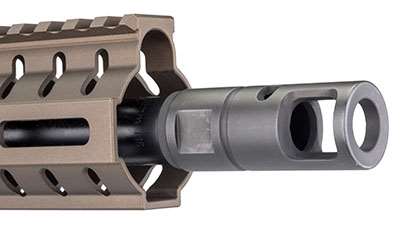
Affixed to the end of the gun’s medium-contour, 4140 chrome-moly steel barrel is CMMG’s SV muzzle brake, threaded .578x28 TPI should the user want to replace it or mount a silencer. While the others are only set up for right-handed use in their stock configurations, the Banshee 300 is southpaw-friendly straight from the factory, with bilateral safeties and a charging handle set up for ambidextrous use.
The lower’s flared magazine well has been shaped to accept Glock-style box magazines, and one 30-rounder from SGM Tactical is included; compatibility with Glock magazines does require the use of a re-designed magazine release button, but the levering control operates identically to the standard, push-button component.
In regards to our testing protocols, I treated the Banshee 300 as I would any 8"-barreled pistol, shooting for accuracy at 25 yds.—and befitting its short-range applications as a defensive arm, a close-in hunting tool and a range gun—I mounted an unmagnified red-dot atop it in order to do so.
With the exception of one load that it did not care for, most five-shot groups averaged about 1.2", pretty good accuracy given that the 3-m.o.a. reticle completely obscured my target’s bullseye at that distance. Reliability—with the correct buffer installed for the ammunition being used—was 100 percent. Just for the sake of experimentation, I did run some of the light Barnes load (power factor 184) using the H3 buffer, and while it still cycled most of the time, the rare double-feed did occur.
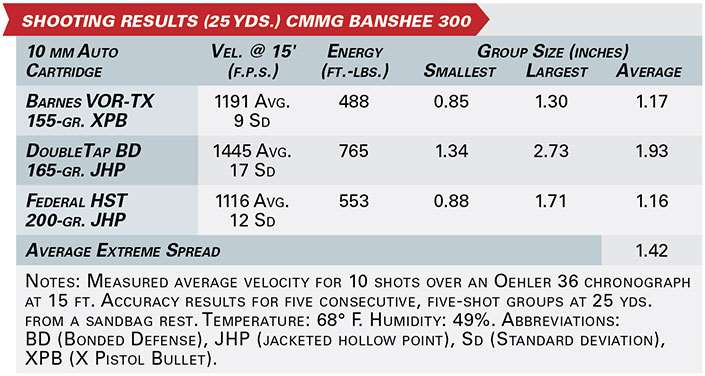
AR pistols are a lot of fun to shoot, and the 10 mm Auto is a lot of fun to shoot, so it shouldn’t be shocking that my range sessions with the Banshee 300 were no chore whatsoever. Despite its light weight, recoil is entirely pleasant thanks to the RDB system, however, its short barrel ensures that this banshee sure does scream. The 10 mm has evolved into something of a cult classic in recent years, and given this firearm’s accuracy, reliability, shootability and feature set—not to mention the slight uptick in velocities its 8" barrel produces—I can see fans of the cartridge scooping these up in droves.
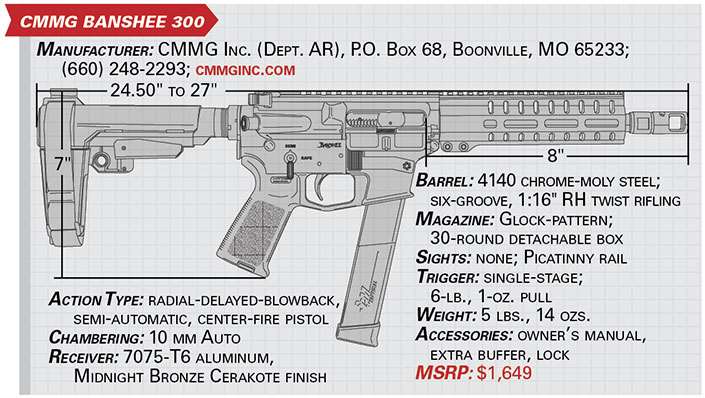

Resolute 100 (.300 Blackout)
More conventional in form for the AR pattern, my test Resolute is an M4-style 16"-barreled rifle with a carbine-length DI gas system and a standard carbine-style receiver extension. One of the chief design perks of the .300 Blackout cartridge is its compatibility with standard .223/5.56 AR-15 parts, which as we’ve previously discussed, are quite pervasive. As a result, CMMG can utilize the same bolts, BCGs, buffer assemblies, gas tubes and magazines with this cartridge as it does in its .223 Rem.-chambered guns—in fact, the 30-round Magpul PMAG that ships with the rifle is marked for 5.56x45 mm NATO use.
With the 100-tier Resolute comes a lot of mil-spec parts. While the other two test rifles sport upgraded muzzle devices, Magpul MOE pistol grips and integrally machined trigger guards, this rifle makes do with A2-pattern parts for the former two and a flat, roll-pin-attached unit for the latter. Simple but effective, a classic M4-type buttstock also comes with the Resolute 100, and it is adjustable to six LOP settings.
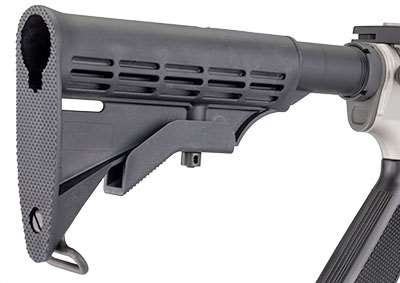
Despite these more austere elements, overall build quality of the Resolute 100 was very good, and as you’ll see shortly, function testing of this gun went flawlessly. Many of these parts are the first to be removed and replaced by those like myself who are particular about their ARs’ furniture and components, and given the $200 savings offered by the Resolute 100 relative to the same cartridge’s Resolute 200, this rifle may be the best choice for fastidious shooters such as myself.
There’s no denying that, mathematically, .300 Blackout generates more recoil energy than does .223 Rem., but for some reason I have always personally found the larger-caliber Blackout to be the much more pleasant to shoot of the two—and the 400 or so rounds of testing through the gun required for this story were a delight. Although I primarily ran supersonic ammunition during function testing, a few magazines’ worth of subsonic cartridges also fed, fired and ejected without issue.
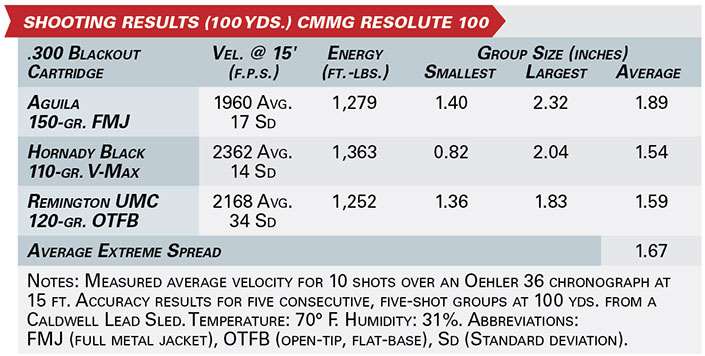
Accuracy testing was conducted at 100 yds., using a 1-4X optic set on its highest magnification, and given that fact, the corresponding results are quite impressive. The five-shot, five-group average of three loads came to 1.67", and I have no doubts that the gun is capable of even better accuracy than that with a higher-power optic. Although enthusiasm for .300 Blackout has cooled a bit recently compared to the acclaim it was getting five years ago, guns chambered for the cartridge still sell well for CMMG, and it remains a potent home-defense and short-range-hunting round, as well as one of the very best options for .30-cal. suppressor users.
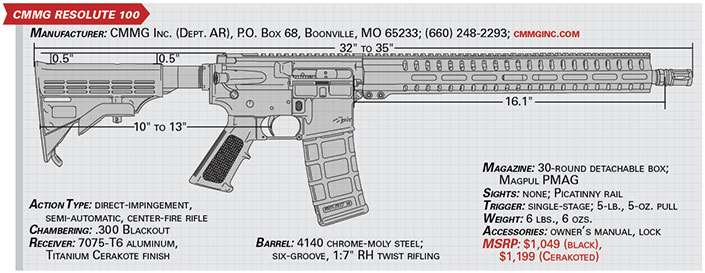

Endeavor 200 (6.5 mm Creedmoor)
Five years ago, even more rare than the non-NATO AR-15 was the AR-10 found in anything other than .308 Win. However, the ascendant popularity of the 6.5 mm Creedmoor since that time has prompted a small number of AR makers to take a chance on this short-action cartridge in the platform—CMMG among them. The company’s Endeavor 200 chambered for the Creedmoor was designed primarily to be a hunting tool, with the Endeavor 300 instead occupying the precision long-range-shooting niche, as the shorter 20" barrel and lightweight, non-adjustable buttstock of the former make it far more pleasantly totable than the 24" barrel and Magpul PRS of the latter.

Built on DPMS-style receivers, whereby the lower rear corner of the upper and the corresponding contour on the lower receiver are curved rather than slanted, the Endeavor 200 employs a 13" rifle-length DI gas system and a rifle-type receiver extension. The gun comes with Magpul’s MOE Rifle stock installed, a streamlined fixed buttstock with an integral sling loop, an interior storage compartment and provisions for dual, ambidextrous QD sling sockets. The Endeavor 200’s upper receiver does not incorporate a forward assist. Its medium-contour barrel is made of 416 stainless steel, and is topped with an SV brake threaded at 5/8x24 TPI.
Unfortunately, early in my testing, the sample Endeavor was essentially a single-shot. Using the included 20-round Magpul PMAG, after each shot the spent case would either fail to eject entirely or would successfully eject but with the bolt then failing to pick up the next cartridge as it returned to battery. Fortunately, it appears to have just been a case of the break-in gremlins, as things smoothed out entirely before I even took a break to investigate the problem; firing and manually cycling through two magazines’ worth of ammunition was enough for the rifle to sort itself out. In subsequent testing, it ran without further complaint, using not only the factory 20-rounder, but also Lancer L7s and even Magpul’s new PMAG D-50 drum.
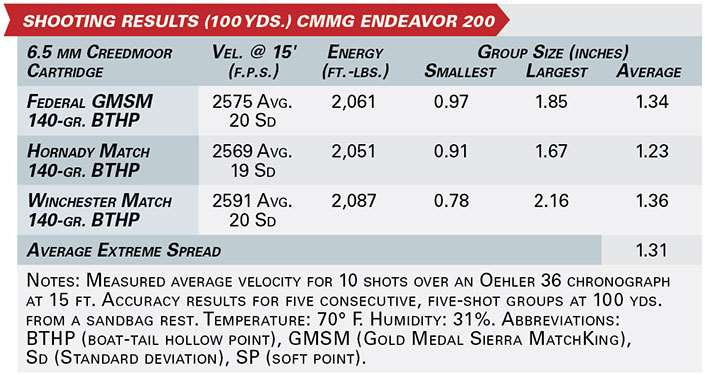
Accuracy testing was conducted using American Rifleman’s established protocol of five consecutive, five-shot groups at 100 yds., using a 4-20X riflescope set at 20X. The Endeavor 200 fared quite well—certainly well enough for its most likely application, deer hunting within several hundred yards. All loads tested managed at least one 1-m.o.a. group, posting a three-load average of 1.31" through the gun, but Hornady’s 140-gr. Match ammunition shot the tightest five-group mean (1.23"), while Winchester’s 140-gr. Match load produced the afternoon’s smallest single group (0.78"). As mentioned previously, this rifle makes use of a decent but unextraordinary mil-spec trigger, and the above groups would almost certainly benefit considerably from the installation of an after-market upgrade.
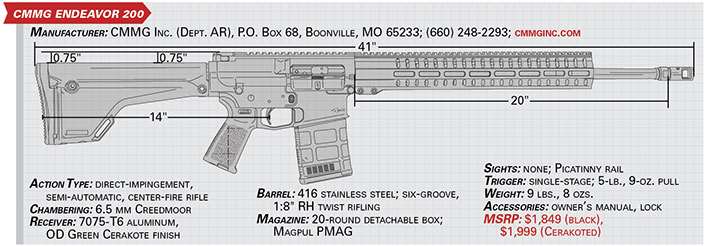
Conclusion
CMMG is built around the passions of owners John and Jeff Overstreet. They were the ones with the insight to recognize that, while the pool of shooters who want non-NATO ARs is not terribly wide, it is much deeper than it appears from the surface, and that the industry at large was underserving these folks.
It is also the leadership of the brothers Overstreet that sets the culture for their company. I had the opportunity to visit CMMG headquarters about six months back, and the place exudes a playfulness and a sense of family not often encountered in the workplace. This is a company intent on remaining close to its roots, one that takes its products seriously (all CMMG products carry a lifetime, transferable quality guarantee), but itself, not so much—those few who know what CMMG is actually short for can attest to that.
After having the rare privilege of standing within CMMG’s engineering department and perusing the list of in-process and upcoming projects displayed on the whiteboard there, I can tell you that the company has no plans to curb its penchant for pushing the AR platform’s boundaries anytime soon. All three of the firearms evaluated for this story proved themselves to be fine examples of their respective branches of the AR tree, but I’m more than a little excited by the prospect that Boonville’s best may be still yet to come.












